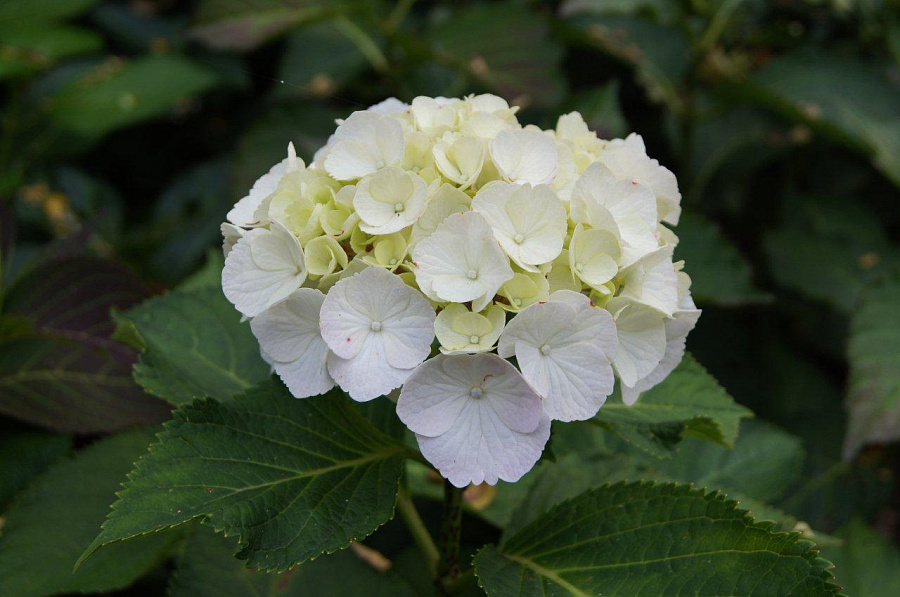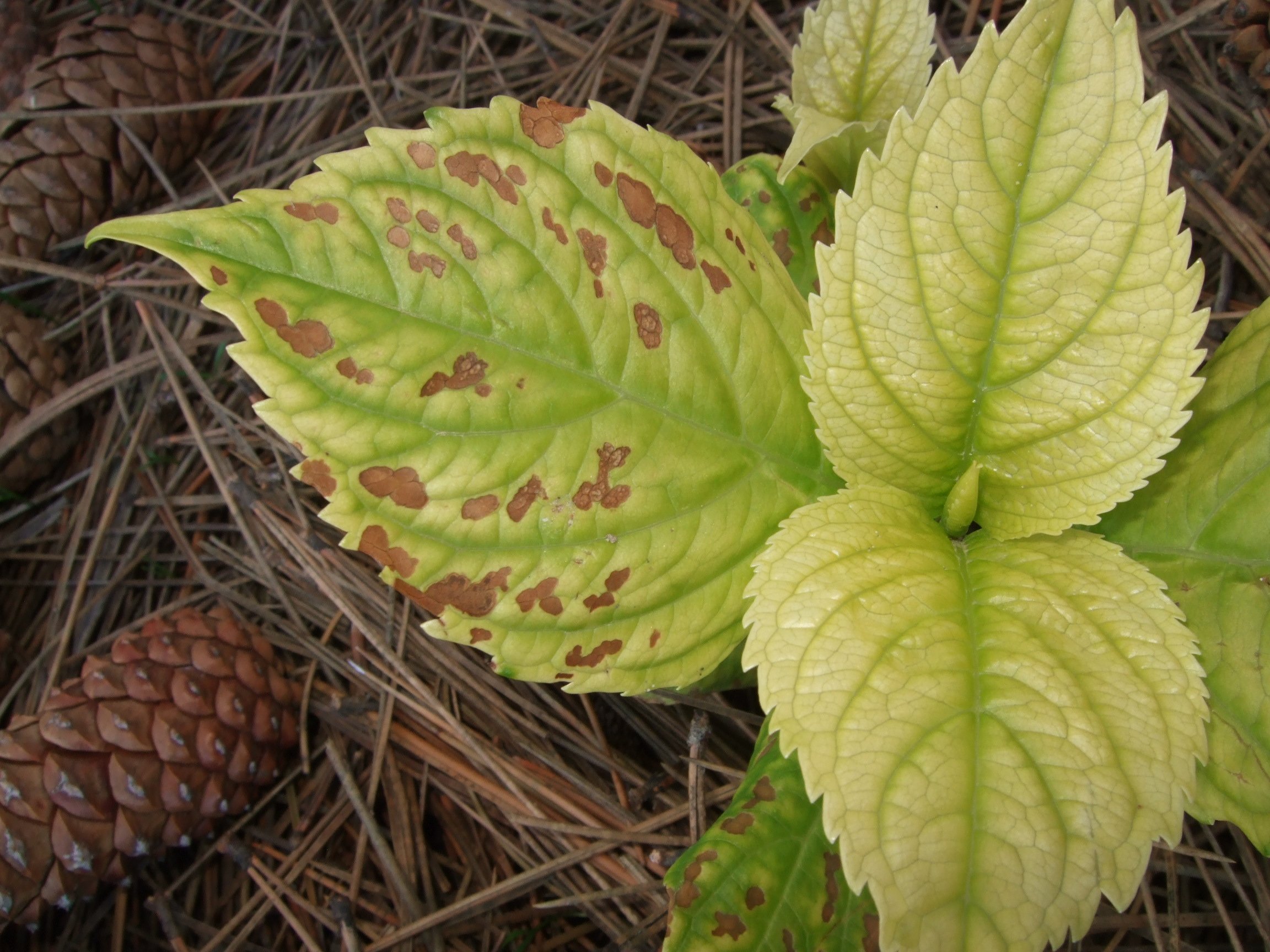Large-leaved hydrangea is a highly decorative, easily propagated shrub that does not feel bad in the gardens of central Russia. Hydrangea planted in the open ground blooms profusely all summer, and the photo will not convey all the charm of a bush strewn with flowers.
More information about hydrangeas
Variety of hydrangea species
There are many types of hydrangeas, but you need to remember that this shrub is thermophilic and requires care.In order for hydrangea to tolerate winter well, you need to choose seedlings of those varieties and cultivars that are able to grow and bloom in your climate.
Top of the best varieties for growing in central Russia:
Large-leaved hydrangea, variety: Miss Saori

Medium-sized shrub, whose height in favorable conditions reaches one and a half meters. In autumn, it retains its decorative effect, since the leaves tend to change color from green to burgundy. The flowering period is from June to October, the inflorescences are collected in large balls, the diameter of which reaches 25 centimeters.
Large-leaved hydrangea, variety: Lenart White

The bush is medium-sized, with simple ovate leaves and large corymbose inflorescences up to 25 cm. Blooms from June to September, feels comfortable in zone 6.
The variety is interesting because in one inflorescence there can be both ordinary flowers and sterile ones. At the same time, the color of the sterile ones is snow-white, while the rest of the flowers are colored.
Large-leaved hydrangea, variety: Doppio Bianco

Compact bush for mixboards or landscape plantings.. It grows up to 1 meter, in autumn it also changes the color of the leaves to a bright orange – red. Pleases the eye with spherical white inflorescences from the end of May to the end of October, prefers the 5th zone.
Large-leaved hydrangea, variety: Red Baron

One of the best hydrangeas with red colors. A compact shrub up to one and a half meters, with bright foliage and balls of scarlet flowers pleases the eye from July to August. Prefers the 6th zone of agriculture. Under the influence of the acidity of the soil, the petals tend to change the intensity and shades of color.
Large-leaved hydrangea, variety: Pink wonder.

A neat compact bush is closer to a small size (up to 80 cm). As it is clear from the name of the variety, its flowers are pink, large, collected in balls. Do not change color due to the acidity of the soil. It is recommended for cultivation in the 6th zone, the flowering period is from July to September.
Large-leaved hydrangea, variety: Forever and Ever

One of the most famous repair types. The bush is compact, medium-sized, up to 1 meter in height. It has glossy dark green leaves and huge balls of inflorescences that can change their shades. In the 5th zone, it blooms on the shoots of the past and this year, blooms from June until frost, for which we especially appreciate gardeners.
Large-leaved hydrangea, variety: Nikko blue

A tall variety, under favorable conditions in the fifth zone can grow up to one and a half meters. It has bright green leaves and lush inflorescences. The flowers range from pale blue to bright blue, depending on the acidity of the soil. The higher the Hp, the brighter the color of the petals.
Care of large-leaved hydrangea
Hydrangea grows well and blooms in pots with proper care, but it is impossible to grow a bush and propagate it with such planting: this requires open ground. The pit for transplanting a seedling from a shipping container into the open ground must be carefully prepared and transplanted hydrangea on a cloudy windless day. Planting is carried out in spring or autumn, while spring transplants give more chances for good survival of the plant and its safe wintering. Hydrangea is light-loving and prefers well-moistened soils, but tolerates partial shade. But we must understand: the less light a bush receives, the smaller its inflorescences will be and the dimmer the color of the petals. In order for the hydrangea to be comfortable, it is necessary to choose a place protected from the wind, where the bush will receive sunlight 6-7 hours a day. Fertilizers for growing hydrangeas are mandatory.Hydrangea is thermophilic and does not tolerate frost, even – 10 can harm the health of plants. Young shoots and buds can die even during frosts, in order to avoid this, it is necessary to shelter seedlings and adult plants.
Why does the large-leaved hydrangea not bloom?
The main reasons for the lack of flowering are:
- freezing of flower buds;
- rapid shrub growth;
- excess nitrogen fertilizers applied;
- incorrect or untimely pruning;
Preparation of the landing pit
The land on the landing site must be dug up and humus, peat, sand and turf must be introduced into it in equal parts.
The pit for large-leaved hydrangea should be large enough, with sides of 40-50 centimeters.
If the soil in the garden consists of loam or has a large admixture of clay, then the pit will have to be drained: pour a sufficient layer of crushed stone, sand and gravel on the bottom. Hydrangea of any kind likes good regular hydration, but does not tolerate stagnation of water at the roots.
After the initial preparation of the pit for the shrub, you need to add chemical compounds to it that affect the tone of flowering. The fact is that the color of hydrangea petals depends on the acidity of the soil, and if the pH becomes more than 5.5, hydrangea will inevitably change from blue-blue color scheme to pink – red. In order to avoid changing the color of the petals, it is necessary to maintain the acidity at the planting site of the shrub. In order for varieties with blue flowers to retain their brightness, natural acidifiers should be added to the soil: peat, bark (needles) of coniferous trees or fertilizers. It is also necessary to feed the color with aluminum sulfate, the solution of which is prepared at the rate of 15 grams per 1 liter of soft water.
Reproduction of hydrangeas
Hydrangea reproduces quite easily with the help of cuttings.The apical flowering shoot containing at least three leaves should be cut off below the leaf node at a slight degree with a sharp knife. Dip the cut into any root formation stimulator and place it in moist soil. To facilitate rooting, you can remove the upper halves of the leaves – this will reduce the evaporation area. Further care consists in transferring cuttings to partial shade and regular moistening of the soil.
Hydrangea is also propagated by layering.In summer, it is necessary to dig a shallow trench near the bush, bend the lower young shoot selected for reproduction to it and cover it with earth so that a small upper end remains on the surface. Previously, with a sharp knife, it is necessary to remove the bark with a ring with a width of three to four centimeters at the point of contact with the soil.If rooting is successful, next autumn you can transfer a young seedling to a new place.
It is permissible to divide large old bushes by cutting the root ball with a shovel, so that with this method of reproduction two adult grown plants turn out at once.
Diseases and pests
Unfortunately, large-leaved hydrangea tends to be exposed to a large number of diseases, but proper care of the plant reduces the risks of diseases. You can identify them by comparing the affected sheet and the photo on the Internet, the “Photo Search” in Yandex or Google also helps well. The most common of them are:Chlorosis. It can be identified quickly:Hydrangea leaves lighten or turn yellow, lose color, become covered with spots. This is due to hard water for irrigation, low soil acidity, lack of nutrients.

There is no specific treatment, in order for the plant to feel better, you need to adjust the watering regime of the plant, pay attention to the composition of the soil and adjust it with fertilizers.To prevent chlorosis, it is recommended to spray the bush with a solution of iron sulfate in a concentration of 50 grams of powder per 10 liters of water every ten days.
Powdery mildew is a dangerous disease of a fungal nature. When infected with powdery mildew, spots appear on the leaves, “powdered” with a white coating. The disease tends to rise rapidly from the bottom up, it affects more and more leaves and stems, and without timely treatment, hydrangea can die.
Powdery mildew occurs due to sharp fluctuations in humidity against the background of high air temperature, high nitrogen content in the soil and frequent dense planting of shrubs.In order to cope with powdery mildew, it is necessary to cut off all damaged shoots, adjust the watering and fertilizing regime, spray the ailing shrubs with Bordeaux liquid, Angle and other means.
Rust. Reddish-orange spots caused by the fungus appear on the leaves and stems of the affected plant. As a rule, the disease manifests itself after wet, sunless weather and in conditions of dense planting.
Treatment of the plant consists of jet treatment with copper chloride in a concentration of 40 grams per 10 liters of water. Watering should be generous, spending at least two liters per bush.
Bushes are not bypassed by all kinds of garden pests. Aphids, slugs, and snails like to settle on fleshy juicy shoots. Shortensii are also susceptible to attacks by nematodes, leaf-twigs, scabies and other garden parasites. The fight against them is carried out using modern ready-made preparations.
Large-leaved hydrangea belongs to the class of moderately toxic plants, which means that neither people nor animals can eat parts of the shrub. It’s unlikely that anyone would think of cutting such a beauty into a salad, but it’s worth warning.
Popular questions:
Breeders have created a sufficient number of frost-resistant species, and many of them comfortably winter in 5 and 6 farming zones. The plants of the Endless Summer group are best suited for non-hot climatic zones. And in any case, we must remember about the need to shelter hydrangeas for the winter. Without shelter, the bush will lose flower buds and may die entirely.
Yes, this plant is a chamelion. With artificial acidification of the soil, it is possible over time to achieve the transition of colors from pink-red to blue. The reverse process is much easier and faster.
Definitely yes, it is worth it. Firstly, the high decorative quality of the shrub deserves the effort, and secondly, hydrangea is responsive to care. It tends to adapt well, and over time it tolerates cold winters and not quite ideal soil composition more easily.







